This week we explore the science of Heart Disease. Dr Niall Campbell joins us to explain what heart attacks are and how they're treated, Dr Anthony Mathur discusses how stem cells might hold the key to mending a broken heart, and Ben Valsler visits Brian Callingham to investigate how arteries behave when you give them various drugs.
In this episode

Can stress provoke heart attack?
We need some amount of stress in our lives. Stress gives us motivation and enthusiasm. Some people however would suffer a heart attack when they are feeling especially stressed, but it's likely that the heart attack would probably have occurred anyway. If you don't have narrowing in your arteries, stress on it's own would not bring about a heart attack.

- What causes heart palpitations?
What causes heart palpitations?
Generally the left side of the heart is bigger than the right.
A palpitation is when someone is aware of their own heart beating. That's quite common and I'm often aware of my own heart beating specially when I'm in bed going to sleep, but being aware of your heart beating is not necessarily abnormal. Lots of things can cause palpitations, but the times when it requires investigation is when someone is aware of their heart beating and feel very unwell, or when their heart beats quickly for a long time or they feel light headed. Sometimes it can be normal and sometimes it requires further investigation.

What controls the heart rate?
The heart has a very well designed electrical system, which has it's own internal pacemaker that beats very regularly, a bit like a metronome. That metronome will speed up if the heart needs to beat faster, for example at times of exercise or stress. The heart will beat slower when we are relaxed, for example when we are resting or when we are asleep at night. The heart has a well regulated metronome, however there are some conditions where that metronome can become damaged or impaired. In these cases we can fit the person with a pacemaker, which is a small box that sits just underneath the person's collar bone and feeds wires inside the heart; taking over the heart's own pacemaker at times when it becomes impaired.

Could a leaky heart valve be fatal?
There are a wide range of leakiness of different heart valves. A mild degree of leakiness of particular heart valves is not always necessarily sinister, but if someone has a very leaky heart valve left untreated it could be fatal. If you have been told that you have leaky heart valve, it's worth asking about how leaky it is and what can be done about it.

- Why does heart surgery mean you need antibiotics for other surgery?
Why does heart surgery mean you need antibiotics for other surgery?
If someone has a leaky valve or a very narrow valve, they may need a heart valve operation where either an animal valve or a special metal valve is put inside the body. If someone has a dental procedure, we know that the bugs from the mouth can spread around the body and those bugs can seed around the heart valve. Antibiotics are given at the time of a dental procedure to people who have had heart valve surgery to prevent that seeding from occurring.

Canny birds in Chernobyl
Birds around Chernobyl seem to be avoiding radioactive nests. Anders Møller from the Marie Curie University in Paris and Tim Mosseau in South Carolina have been studying the birds around chernobyl.
The background radiation in the Red Forest, 2-3km away from the Cherobyl reactor, is very variable so they built nesting boxes for Great Tits and Pied Flycatchers in lots of different sites in the area.
Both birds but particularly the pied flycatcher avoided the most contaminated areas, with the Flycatchers only nesting in the least contaminated areas. Although they have idea how they are doing it, this is a very sensible thing for the birds to be doing as the radiation will have a bad effect on the birds, although if wildlife is able to detect the really dangerous areas, this may be contributing to the huge growth in wildlife in the exclusion area around Chernobyl.
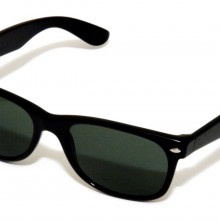
Almost perfect anti-reflection coating
If you are making a camera, telescope, solar cell or microscope, you don't want light being wasted by reflections or even more critically if you are in the military you don't want your position being given away by reflections.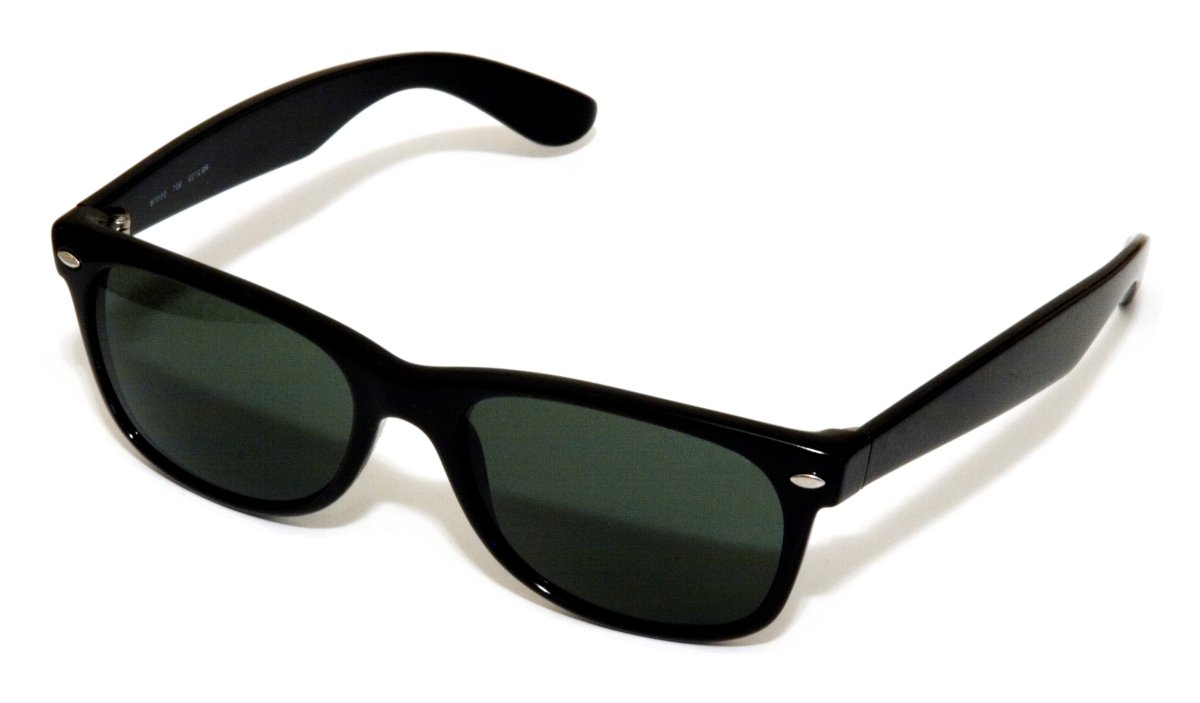
So you want to coat your lenses with somthing to stop them reflecting. Traditionally this is done by adding a thin coating of another material of the right thickness so that the reflections from the surface and base of this cancel out giving no reflection. This is great, but it only works well for one colour, this is normally chosen to be green because it is in the centre of the spectrum, so the coating will not work as well for red and blue, so a coated lens will reflect some red and blue light giving it a purple sheen, hence why expensive optical equipment looks purple,
Fred Schubert from Rensselaer Polytechnic in New Your has taken a different approach, Reflections occur when the refractive index of a material changes rapidly, eg going from air to glass. If you can change the refractive index smoothly there will be no reflections. This has been known for a long time, the problem is that no natural solids have a refractive index close to that of air so there will allways be a reflection.
Fred has goat around this by depositing tiny silica nanorods onto a piece of glass. He can vary their density, so he can make a material which is mostly air, so it's refractive index can be as low as 1.05 compared to 1 for air. By changing their density and angle he can build up layers with gently changing refractive index to that of glass, making a near perfect anti-reflection coating.
Do identical twins have identical DNA?
Identical twins do have identical DNA. They form when a fertilised egg, (that is when one sperm has joined with one egg to form a growing embryo) splits in two and it develops independently as two separate embryos. Because both halves originated from the same genetic material they are genetically identical. They are nature's clones and happen naturally in humans and some animals. In fact the nine-banded armadillo naturally produces four genetically identical offspring.
So twins are genetically identical but fingerprints differ amongst identical twins. The reason is that fingerprints are a developmental random process. When cells are migrating in the body, there are codes and chemical messages that tell them where to go in the body to put the body together, but when the cells get to their final destination, how they arrange themselves is much more random. Fingerprints are a consequence of this arrangement, so you will see a very individual picture to a person's fingerprints but of course their genetic fingerprint is going to be the same.
So your DNA doesn't tell you exactly how to build you! It's a bit like giving someone building instructions on how to build a wall, it doesn't tell you exactly where to put each of the bricks?
Is a microwave sealed?
I have tried this at my girlfriend's house and it did actually cut out the phone connection, so the microwave oven does keep some of the microwaves coming out of the phone, inside the microwave (oven). The frequency of the microwaves from a phone is not the same as the microwaves you use for cooking, if they were the same, then every time you turn the microwave on you wouldn't be able to talk on the phone, because you would get horrible interference.In fact there is a gap (between the door and the main body of the oven), but the microwaves don't get out of this gap, because it's (the gap) tuned to be exactly a Ã?,¼ of the wave length of the microwaves. As the phone works at a different frequency, some microwaves from your phone will get out of this gap. So the oven will cut down the microwaves (from the phone) coming out of it but it won't cut it out completely because it's the wrong frequency. On the other hand, the phone will also turn up it's power to make itself work!
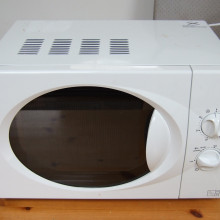
Is heating water in a microwave dangerous?
Yes it can be true. If you heat water very gently in a very clean container, you can actually get it to be above 100Ã?,°C, maybe 105Ã?,°C or 106Ã?,°C.
And if the temperature of the water is 105Ã?,°C, it will do you more damage more quickly. Also if you put in some sugar then it will boil quickly and explode all over you, and some people have been badly hurt by putting spoons into things and heating it in the microwave.

Why butter is so hard to spread on newly baked bread?
Peanut butter is rich in vegetable oil and that means it has unsaturated fats in it. An unsaturated fat has double bonds between the carbon atoms, which cause the hydrocarbon chain to bend. This bending causes the molecules not to stack together tightly, which means that the peanut butter is less dense and therefore will spread more easily than something that contains saturated fats.
Saturated fats have single bonds between the carbon atom so they stack together more closely and are very dense. So because butter is more dense, it's harder to spread than peanut butter. This means that butter forms globules and sticks to itself rather than spreading out evenly on the bread.
It might also be that if the bread has just come out of the oven, it's still warm and the melting point of unsaturated fats is lower than saturated fats, so the peanut butter (unsaturated fat) would get runnier (start to melt) quicker and becomes easier to spread.

18:32 - Science Update - Puberty and Death
Science Update - Puberty and Death
with Chelsea Wald and Bob Hirshon
Bob - This week for the Naked Scientists, we're going to talk about puberty and death. I'm going to talk about why seemingly trivial problems can send teens into rage or depression, but first, Chelsea's going to tell us why a computer may someday make some of your toughest decisions for you. Chelsea - Computers could someday make end-of-life decisions for people who can't communicate and haven't left any record of their wishes. Bioethicist David Wendler of the National Institutes of Health says the program predicts what medical care people would want based on the preferences of similar people. Even with just a little data, the program guesses with the same accuracy as family members--just about 70 percent. Wendler says more data could up that to 90 percent.David Wendler (National Institutes of Health): So basically what our findings show is that I can do a better job at predicting your end-of-life treatment preferences by looking at the preferences of people who are like you in similar ways (age, gender, race, religion, etc.) than I can by asking your wife of 40 years.Chelsea - Why that is, and how that wife would feel about letting a computer decide her husband's fate, still aren't known. Bob - Thanks, Chelsea. Teenagers are known for extreme mood swings, generally blamed on hormones. Now, scientists may have figured out why. Neuropharmocologist Sheryl Smith at the State University of New York Downstate Medical Center explains that during stress, the body releases a chemical called THP that causes a tranquilizing effect on nerve cells in the brain's emotion center. Sheryl Smith (SUNY Downstate Medical Center): And so it will allow you to adapt a bit to the stress, to not feel as freaked out, and calm down a little and be able to handle the stress.Bob - But in young mice, she found that hormones during puberty alter these brain cells, so when THP reaches them, instead of triggering a calming effect, they trigger extreme anxiety. If the mouse model holds true for people, it's easy to see why stress that seems mild to adults could lead to extreme anxiety in young teens.Chelsea - Thanks, Bob. Next time we'll bring you more stories from the land where overreaction is a way of life. Until then, I'm Chelsea Wald...Bob - And I'm Bob Hirshon, for AAAS, The Science Society. Back to you, Naked Scientists!
Chelsea - Computers could someday make end-of-life decisions for people who can't communicate and haven't left any record of their wishes. Bioethicist David Wendler of the National Institutes of Health says the program predicts what medical care people would want based on the preferences of similar people. Even with just a little data, the program guesses with the same accuracy as family members--just about 70 percent. Wendler says more data could up that to 90 percent.David Wendler (National Institutes of Health): So basically what our findings show is that I can do a better job at predicting your end-of-life treatment preferences by looking at the preferences of people who are like you in similar ways (age, gender, race, religion, etc.) than I can by asking your wife of 40 years.Chelsea - Why that is, and how that wife would feel about letting a computer decide her husband's fate, still aren't known. Bob - Thanks, Chelsea. Teenagers are known for extreme mood swings, generally blamed on hormones. Now, scientists may have figured out why. Neuropharmocologist Sheryl Smith at the State University of New York Downstate Medical Center explains that during stress, the body releases a chemical called THP that causes a tranquilizing effect on nerve cells in the brain's emotion center. Sheryl Smith (SUNY Downstate Medical Center): And so it will allow you to adapt a bit to the stress, to not feel as freaked out, and calm down a little and be able to handle the stress.Bob - But in young mice, she found that hormones during puberty alter these brain cells, so when THP reaches them, instead of triggering a calming effect, they trigger extreme anxiety. If the mouse model holds true for people, it's easy to see why stress that seems mild to adults could lead to extreme anxiety in young teens.Chelsea - Thanks, Bob. Next time we'll bring you more stories from the land where overreaction is a way of life. Until then, I'm Chelsea Wald...Bob - And I'm Bob Hirshon, for AAAS, The Science Society. Back to you, Naked Scientists!
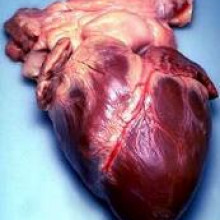
21:29 - What is Heart Disease
What is Heart Disease
with Dr Niall Campbell, Heart Attack Centre at the London Chest Hospital
Chris - Heart disease, apart from killing one person in three who will be listening to this programme, must be a very broad term; it must be one of the most mis-used terms, what does it actually mean?
Niall - It is a broad term, it covers a wide variety of different problems. People can have problems with their heart arteries, the heart muscle, the electrical circuitry of the heart; for which some of those patients will need pacemakers. Some of those problems will overlap, for example a patient who develops problems in the heart arteries may go on to develop a problem with the heart muscle or the electrical circuitry of the heart.
Chris - Who gets it?
Niall - Anyone can get it, some people specifically in terms of people who have narrowing in the walls of the heart arteries, and there are certain risk factors for that. People who smoke are more likely to get it, people who have diabetes, high blood pressure or high level of fats in the blood can get it.
Chris - When we say 'you've got problems with your heart', what's actually provoking those problems and how would the factors you just mentioned lead to the condition?
Niall - Essentially, going back to basics, the heart is a pump. A large muscle is the engine system of the heart and the engine needs it's own plumbing system, called the coronary arteries. The coronary arteries can, if we live in a western society, develop narrowing over time and all of the factors I mentioned can encourage narrowing to occur. If those narrowings become very severe, or if a clot develops in one of the heart arteries, then one of those arteries can become blocked, the area of muscle supplied by that particular coronary artery can become damaged, and that it what's known as a heart attack.
Chris - What's actually going on in the artery, to get that furring up, those plaques that are made of that fatty material?
Niall - Essentially each artery has got three layers. Its got an inner layer, which is closest to the blood; a middle layer, which has a muscle layer which allows the body to regulate the diameter of the artery, we can also give particular drugs to change that size. There's also an outer lining, which connects the artery to the outer structures. For example when people smoke or have high levels of fats in their blood, they are more likely to develop fatty deposits on the inner lining of the artery. That can pre-dispose people to heart attacks.
Chris - So why does it take 40 or 50 years for this to manifest, and why does it run in families?
Niall - Even if you look at very young children, you can see if you live in countries such as ours with our diet and our lifestyle, that the basic building blocks of these fatty deposits are beginning to occur. Narrowing occurs over many years, it's often only when they get into their 40s or 50s that those narrowings will occur. There are some people with family conditions who are more likely to develop heart disease, often conditions where they have very high levels of fats within the blood. If you have high levels of fat within the blood, fatty deposits are more likely to develop and that makes heart disease more likely to occur.
Chris - So is there anything we can actually do once these vessels become furred up in this way?
Niall - There are medicines which can treat it, if someone is actually having heart attack and the heart artery completely blocks, there are two main treatments which doctors can use. The first is the use of 'Clot-busting' drugs, a treatment we call thrombolysis, where very strong clot-busting drugs are given into somebody's vein to open up the clot. Newer treatments are being developed where we can pass wires and tubes up from the top of someone's leg or wrist directly into someone's heart artery. While the patient is awake, we can open up the heart artery and place a special metal scaffold, called a stent, to keep the artery open.
CHRIS - Why do you need that metal scaffold? Why can't you just squash the fat out of the way and be done with it?
Niall - When we pass wires and balloons down people's heart arteries that does cause some local damage to the artery, and there is evidence that actually putting a stent in will stop it furring up later.
CHRIS - So what's the difference between that and a heart bypass?
Niall - Imagine the heart arteries as pipes, and imagine a blockage. In the same way as a road bypass will go around a town which causes a lot of congestion, a heart bypass takes one of a persons own arteries or veins, connects it to the area before the blockage, and then to the area after the blockage, bypassing the blockage. It's not actually opening up the artery itself, it's encouraging flow beyond the narrow.
CHRIS - So this approach you mentioned when you can thread something up from the leg is going to be a lot better than having to give someone a pretty serious operation.
Niall - Certainly when someone is having a heart attack, people who do heart bypass operations would say that it's preferable that someone has this procedure with a stent. However, some people will need a heart bypass operation if they have had a heart attack. These operations are also done in patients who haven't had heart attacks, as there may be other good reasons to operate, such as severe narrowing in a lot of important arteries.
CHRIS - As you go further down an artery it gets smaller and smaller, what about when the vessel gets so small that the damage is beyond the reach of one of these techniques?
Niall - There is a range of very good tablets which can be used to treat symptoms and also there's a lot of new research such as using stem cells to try and improve the heart function.
CHRIS - When someone has a 'Heart Attack' what does that mean compared with a 'Cardiac Arrest'?
Niall - That causes a lot of confusion for many people. A heart attack is actually when one of the heart arteries blocks up, and results in an area of heart muscle actually dying. The larger the area of muscle supplied by that artery, the more damage will occur to the heart muscle.
A cardiac arrest is when the heart actually stops beating. There's a variety of things that can cause cardiac arrests; heart attacks can cause cardiac arrest but, for example, if someone were to develop a large blood clot in their lungs that could also cause a cardiac arrest.
Dave - When some of the heart dies in a heart attack, does it ever re-grow or is it just gone forever?
Niall - At the moment, what we know is that the heart muscle can't come back to life once it's died. If the heart attack has been small, or moderately sized, then the other areas of heart muscle which haven't actually been effected by the heart attack can take over the function of the damaged muscle. That can still allow the heart to work quite effectively.
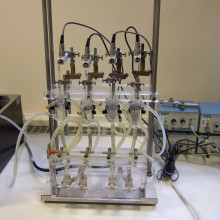
Stimulating Arteries
Ben - Hello! I'm here in the Department of Pharmacology with Brian Callingham. What are you going to show us today Brian?
Brian - I'd like to show you how arteries work.
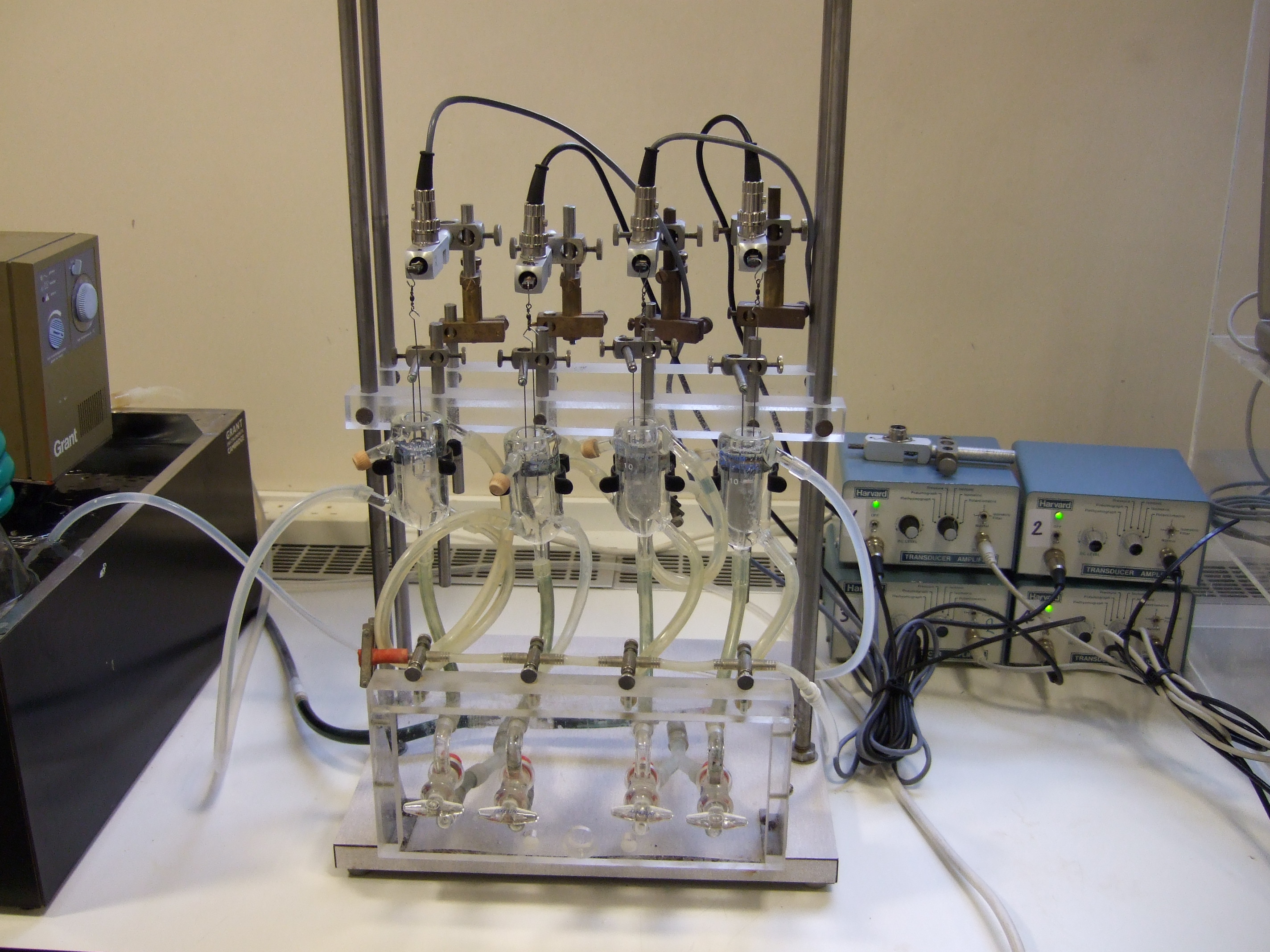
Ben - Work in what sense?
Brian - Work in the way in which they respond to drugs in particular, both for good and for ill.
Ben - So how do arteries generally respond?
Brian - They respond either by contracting or by relaxing. They have to control the blood supply to various organs and tissues of the body. A good example is that in cold weather you want the blood vessels in your skin to constrict so that you don't lose heat. Conversely in the summer you would like them to relax and dilate so that you can get rid of heat.
Ben - This equipment is quite scary looking, you might expect to see it in a mad scientists lab; there's glass, there's tubes, there's bubbling, there's metal; what is it all for?
Brian - The vessels you're looking at, called organ baths, are about three inches high and about ¾ of an inch in diameter and contain a nutrient solution. If you look closely you can find there's a small ring of a piece of the digital artery of the deer, that we obtain from the abattoir. We measure the tension that it develops by putting a wire loop through the lumen, and attaching the loop to a transducer. This transducer measures the force developed by the little muscles in the wall of the blood vessel. The signal is then passed on via an amplifier to be recorded by a computer.
What I would like to show you is the effect of some chemicals that we can add to these segments of blood vessel in the organ baths. One is the action of Nor-adrenaline, which is the body's natural stress hormone and involved in the responses of blood vessels when you've received a nasty fright or got angry.
Ben - Brian is using a pipette to add a few drops, only a tiny amount, into the organ bath. Looking at the laptop the graphs at the moment have flat lines, what does that mean?
Brian - That's the resting tension of the arteries before the drug has taken effect...
Ben - Sorry to interrupt, but that's amazing, it's just shot up by at least three times the level it was on, what's happening here?
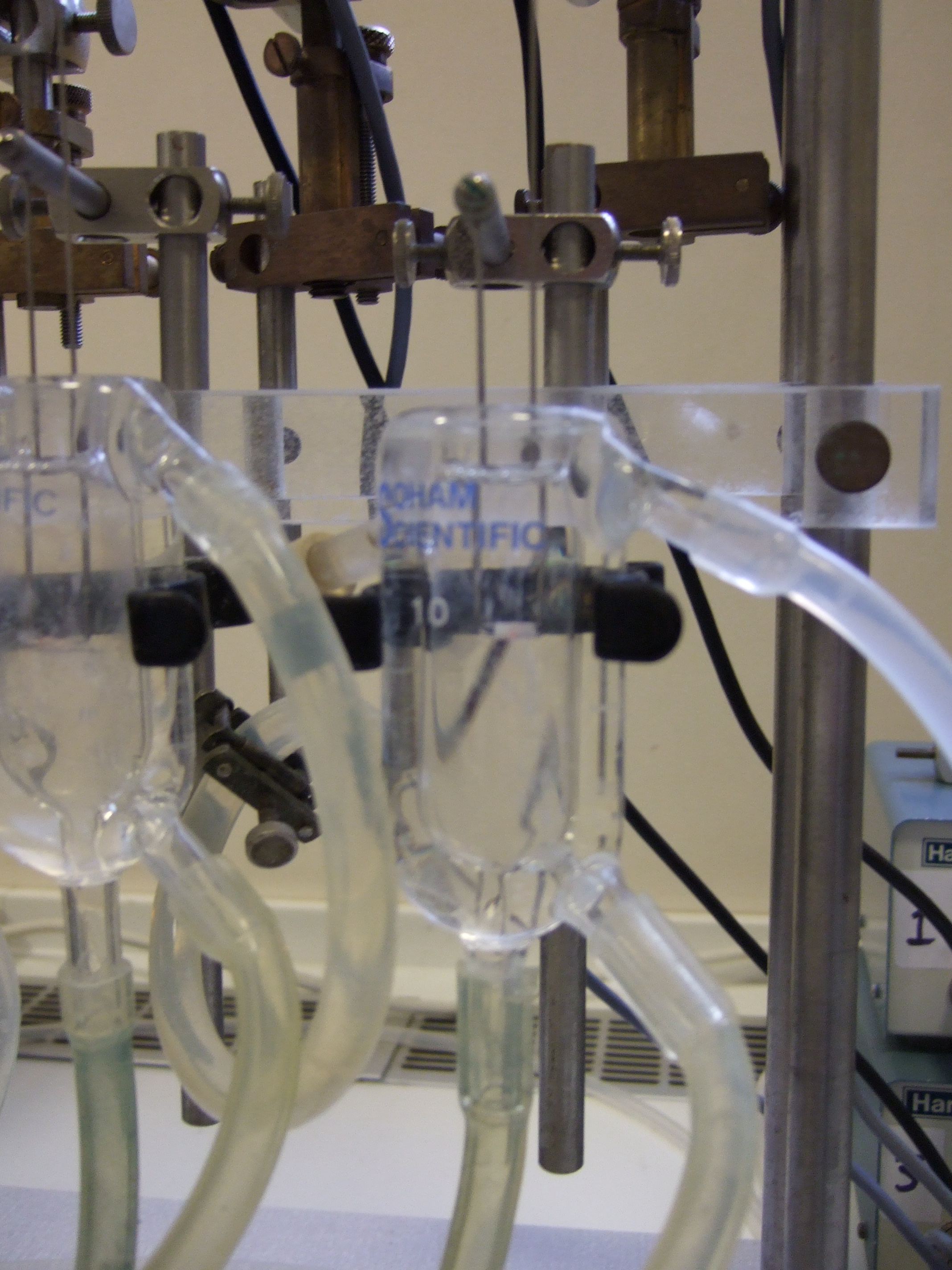
Brian - Well the drug is now having it's effect and causing a very substantial contraction of the circular muscle of the artery.
Ben - Is this the same thing that happens in our own arteries when it's cold?
Brian - Oh yes, what you're seeing here is intense constriction of the arteries, which in us would, of course, reduce the blood flow and thus reduce heat loss.
Ben - So what sort of pressures are you recording? What sort of force is that?
Brian - The force on these little pieces of muscle probably corresponds to about the weight of an AA battery dangling from this little tiny piece of vessel.
Ben - So now that we've made them constrict, is there any way to open them up again?
Brian - Oh yes, there are several ways of doing that. One way, which I would like to show you now, is to use a drug which mimics the action of the drug glyceryl tri-nitrate, which is used for the relief of the terrible pain of angina, when people have cardiovascular disease. So we'll go back to the organ baths now and I will add a similar amount of the drug to the organ bath, lets see what happens.
Ben - Brian's added the other drug now, we're still looking at the same graph, which is still very high. Now, however, it's shooting down, and it really is dropping quite quickly, showing that the artery is opening up again and relaxing.
Brian - This has caused the vessel to relax, which would cause it to open up again blood flow would then go back to normal.
Ben - So how is that useful in the human body?
Brian - The response we've just seen illustrates how these drugs would work in the body for the relief of the pain of angina. The problem with angina is that the heart is deprived of oxygen, very largely as the result of failure of the coronary blood supply, and the pain that it generates is terrible. You want something that works very quickly, as we've seen here. It works very largely by being taken through the blood supply, where it interacts in the endothelium to cause the release of nitric oxide. This nitric oxide then stimulates the processes in the muscle to cause it to relax. As a result of that, you then decrease the work on the heart, it needs less oxygen, and the pain hopefully goes away.
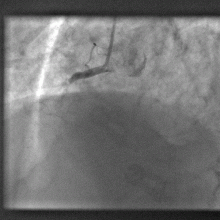
39:11 - Stem Cells for Heart Disease
Stem Cells for Heart Disease
with Anthony Mather, Barts & London NHS Trust
Chris - We've heard from Niall already what a heart attack is and that it leads inevitably to the irreversible destruction of the tissue that makes up the heart, but now we're asking if there's anything we can do to put that right. Stem cells enter the frame here, so how are you trying to investigate this?
Anthony - We're starting with a very simple approach, hopefully a relatively obvious one. We think that adult bone marrow has cells in it that have the potential to repair damaged organs, due to some interesting work undertaken during the last five to ten years.
Chris - Why should it be the bone marrow?
Anthony - All of our textbooks talk about the fact that you're born with as many heart cells as you will ever have, in fact, you die with fewer heart cells. The heart can't regenerate itself, as opposed to the liver, which will grow back again even if you lose a substantial amount of it. Some recent, exciting evidence suggests that the heart might have cells that can regenerate. The question has arisen of where these cells could come from. Clearly with modern diseases the system that can repair and regenerate the heart is not able to deal with the consequences of a heart attack.
Chris - Presumably, when you've had a heart attack resulting in quite serious devastation to a region of the heart, any cells in that region that could have stem cell like properties and could repair that area will, themselves, have been destroyed.
Anthony - Indeed, but there are thoughts that there are little niches or collections of stem cells tucked away around the heart that are able to grow in the surrounding areas; but by no means enough of them. Some evidence that has come to light suggesting that the bone marrow might be producing the body's police mechanism, which goes around looking for the damage that occurs on a daily basis. Every time you knock your arm you're going to lose a few cells here and there, and the system from the bone marrow might well be replacing those few cells that get lost. Unfortunately though, not the large amount of cells that get damaged or lost in a heart attack.
Chris - So how would you aim to manage a heart attack with these stem cells?
Anthony - Our first study, which has recruited about 70 patients now, is dealing with patients who have had heart failures. They've had a big heart attack or several heart attacks at some point in their lives, their heart is damaged and no longer works as a pump. This causes them to get breathless, tire easily, collect fluid on their lungs and lead a poor quality of life. What we have done so far is to take a sample of their bone marrow, process it to get out what we think are the clever cells and inject those cells back into the heart in an attempt to see if they will actually improve.
Chris - When you say 'injected them into the heart' would you put them directly into the damaged muscle, or just into the blood vessel?
Anthony - Both. The research out there at the moment suggests that if you put it directly into the blood vessels around the heart or directly into the heart muscle itself it does have an effect. Our study is actually testing which mechanism, or route, is better.
Chris - Do you actually know how these cells are working? Has anyone managed to do any studies to follow them to see where they go, what they turn into and what changes they induce to happen in the bits of the heart that you think they're effecting?
Anthony - Well that's a very interesting question, the great debate now amongst the scientists who are doing this work is the mechanism. There are at least five different mechanisms by which these cells might be beneficial that have been shown in the animal models. The problem is that although they've shown up to a 40% improvement in heart function in the animal models, it's suggested that it could be any one of those five mechanisms, or a combination of a number of them causing this improvement. In Man it's very hard to demonstrate mechanism as you don't have the same access to what happens to the cells and therefore we don't know for sure how many cells actually stay in the heart and do some good.
Chris - Does it actually have a clinically beneficial effect, in the sense that you have people who couldn't climb stairs or make the bed before, but after this procedure they find they're a lot better off?
Anthony - The answer to that has to be yes, but the problem with this field is that it's dominated by lots of small studies that are not the gold standard of randomised control trials. Our objective is to produce randomised control trials so our patients can make their own minds up. It's a blinded study, so we don't know if our patients receive cells or a placebo, but so far approximately half of our patients seem to have got better and half not. This suggests that something is going on, but it's not until the end of the study that we can unblind it and see exactly what has happened.
Chris - Do you have any feeling for how long the beneficial effect might last for? Some therapies seem to produce a massive improvement to start off with, but when you follow people up for longer the effect seems to go away again. Is there a worry that could happen here?
Anthony - Our study is looking at patients at one year and at six months, so the effects are holding out to at least one year. Beyond that, its such a new area we have no way of predicting what will happen. If we can find a route or a mechanism of administering these cells and taking these cells out of people that is straightforward then we may be able to re-administer cells in an effort to get more improvement or to restore improvement should it start to decline.
Chris - I suppose that another major benefit is that as the cells are coming from the person themselves there are no additional risks from diseases or rejection, as it's not foreign tissue.
Anthony - There are certainly risks associated with this, but as you rightly say it avoids all issues about transplanting across species or human individuals which could lead to rejection and possible transmission of illness.
What is atrial fibrillation?
The heart's rhythm is regulated by a metronome. Some people can develop a chaotic rhythm of that metronome, where by the top part of the heart can become chaotic and the heartbeat becomes irregular. This means that instead of beating regularly like a drum the heart can jump all over the place.
Do we need cholesterol from food?
Actually cholesterol does a lot of good in our body: it's a component in our hormones such as testosterone and oestrogen, it's also responsible for helping to absorb other fats and it also helps making the lining of cell membranes. If someone completely removes all the cholesterol from their diet, then the body will be able to synthesis more cholesterol. However diet only makes one percentage of the cholesterol we take and there are people who have high cholesterol level where the cholesterol thermostat is impaired, those people have to go on special drugs to reduce their cholesterol levels.










Comments
Add a comment